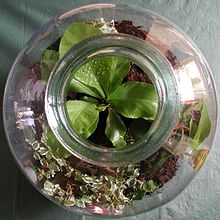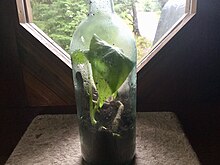
A bottle garden is a type of closed terrarium in which plants are grown. They usually consist of a plastic or glass bottle with a narrow neck and a small opening. Plants are grown inside the bottle with little or no exposure to the outside environment and can be contained indefinitely inside the bottle if properly illuminated. The oldest bottle garden in existence is alleged to have been planted in 1960, and to have remained sealed from 1972 until at least 2013.
Uses
Bottle gardens are commonly used as a form of decoration, or as a substitute garden in areas with little space, such as patios or high rise apartments. Being easy to create and maintain, bottle gardens are also used in schools as an economical way to study miniature eco-systems within the confines of a classroom. They can also be used as a control mechanism, enabling the internal environment of the bottle to be effectively controlled and isolated from outside stimuli. Bottle gardens have also been used for vegetable production in dryland areas and areas with a shortage of water, allowing water to be conserved for other uses.
Operation

A bottle garden has the essential requirements of soil, water, and light for the survival of plants and other organisms that are housed in it, as well as a reservoir of water, as water is trapped inside the bottle and unable to evaporate. The carbon dioxide in the trapped air is used for photosynthesis, and the oxygen produced from photosynthesis is used for respiration and expelled. Aerobic organisms like shrimp, snails, or bacteria take this excess oxygen for their own respiration, and return carbon dioxide to the air. As such they require almost no maintenance.
See also
References
- ^ Robberts, M.B.V. (1986). Biology, a functional approach. ISBN 0-17-448019-9.
- "53 years old Sealed Bottle Garden was last watered in 1972". PickChur. 1 February 2013. Retrieved 27 March 2013.
- "Bottle garden". Retrieved 2008-03-20.
External links
| Hydroculture | |
|---|---|
| Types | |
| Subtypes | |
| Substrates | |
| Accessories | |
| Related concepts | |